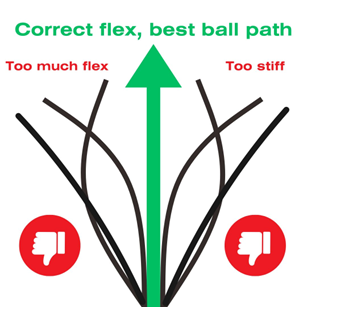What Golf Flex is Best for You?
How to find the proper golf flex for you?
Figuring out the best golf clubs for you is a process we’ve all gone through. There’s a handful to consider and for those just beginning, it can feel like a lot. What’s the right length, proper club head, is the grip comfortable? On top of all that, you need to know what golf shaft flex is right for you and your swing. But first things first, what is golf shaft flex?
What is Golf Shaft Flex? A measure for a golf shaft’s ability to bend during the downswing and at contact.
Why is flex important? A golf shaft’s ability to bend or “flex” will affect the club face’s angle at impact with the ball. Having the wrong flex can increase the likelihood your shot will tail or hook. It also can negatively impact the trajectory or “launch,” sending your shot lower or higher than intended, affecting how far your shot goes. On the contrary, the proper flex can help keep your shots straight and launched at the desired angle and distance.
How do I know what flex is best for me? The main factors that go into choosing the right golf shaft flex are swing speed, gender and skill level. Primarily, it is best broken down by swing speed. The faster your swing speed, the stiffer your club ought to be. The slower your swing speed, the flexier your club ought to be. Typically, gender and skill level directly affect swing speed, hence all three being considered.
One thing to note: the swing speed of your drivers is likely not the speed of your irons. Take that difference into consideration when choosing flex for different clubs.
What are the Golf Shaft Flex categories?
X Stiff: This is where the majority of high-level golfers land. Any folk using X Stiff are swinging those drivers over 105 mph.
Stiff: These are good golfers using Stiff, but they’re not competing at a high level. Drivers in this group are being swung at 97-104 mph on average.
Regular: Regular flex users are most recreational golfers, as well as many LPGA golfers. This group is swinging drivers between 84-96 mph.
Senior: This is where the slower swingers land, including many seniors. But don’t underestimate your elders! They swing their drivers between 72-83 mph with pinpoint accuracy. We have an entire selection of senior clubs that come with the proper flex for your swing speeds. Checkout our Mens Senior Golf Clubs.
Ladies: Not all ladies fall into this category. Majority of recreational women golfers do though, along with anyone else swinging their drivers at any speed under 72 mph. If you're ready to checkout our ladies, clubs which all come with the proper flex for female golfers, explore all of our Womens Golf Clubs.
Golf Shaft Flex Chart
|
Swing Speed |
Flex Type |
Club Type |
Clubhead Speed |
|
Very Fast |
X Stiff |
Driver |
>105 mpg |
|
3-Wood |
>101 mph |
||
|
3-Iron |
>97 mph |
||
|
6-Iron |
>92 mph |
||
|
Fast |
Stiff |
Driver |
97-104 mph |
|
3-Wood |
93-97 mph |
||
|
3-Iron |
90-96 mph |
||
|
6-Iron |
84-91 mph |
||
|
Average |
Regular |
Driver |
84-96 mph |
|
3-Wood |
84-93 mph |
||
|
3-Iron |
80-90 mph |
||
|
6-Iron |
75-83 mph |
||
|
Slow |
Senior |
Driver |
72-83 mph |
|
3-Wood |
70-80 mph |
||
|
3-Iron |
68-78 mph |
||
|
6-Iron |
65-75 mph |
||
|
Ladies |
Ladies |
Driver |
<72 mph |
|
3-Wood |
<70 mph |
||
|
3-Iron |
<68 mph |
||
|
6-Iron |
<65 mph |
What is a “Uniflex” golf shaft?
A Uniflex golf shaft is a specific flex made by Tour Edge. It is the perfect starting place for beginner golfers, which if you’re reading this article, is most likely you.
Since it is intended for beginners, this flex is designed to fit a wide range of players. In comparison to the flex levels mentioned before, Uniflex fits right in between Stiff and Regular, but closer to Regular. Those with medium swing speeds of their driver, sitting somewhere around 90 mph, greatly benefit from this flex. If you’re debating between going with a Stiff or Regular flex shaft, we highly suggest you settle with a Uniflex.
What is the benefit of a “Uniflex” golf shaft?
- Uniflex golf shafts are quite forgiving. This benefits beginner golfers as it can help keep shots straighter and launched at more desired angles. The icing on the cake though is that Uniflex clubs are priced quite fair. Perfect for beginners who aren’t looking to empty their wallets on clubs that may not end up being best for them.
How does golf shaft flex affect your golf game?
- Let’s cut right to it; this isn’t something to shrug your shoulders at. The flex of your golf club shaft will affect the outcome of your performance. The flex of each shaft, from drivers to irons, has a direct effect on ball impact and trajectory.
- As learned above, the faster a swing the stiffer the shaft. Reason being, if one with a fast swing was to use a shaft with more flex, the club face would fall behind your hands and the shaft. If the club face falls behind, the shot can hook quite bad. Oppositely, if one with a slow swing uses a stiff shaft, they typically fail to close the club face, leading to mean slice.

How does golf shaft flex affect the launch of your shot?
As discussed early on, improper flex can negatively impact the launch of your shot. This leads to your ball flying lower or higher, and shorter or longer than intended. It may also cause your shot to feel worse or harsher, which many know is always an uncomfortable sensation. All of the above will do nothing but harm your golf game. Luckily, the easy fix is following our guides to find the right flex for your swing.
*Image is displaying the flex’s effect for a righty golfer. A lefty golfer would be the opposite*
What is torque? Whether or not you’ve seen the term before, torque is quite simple. Torque is the golf shaft’s resistance to twisting during your swing. It is measured in degrees, telling you how much a shaft will twist under any amount of force. You will see anything as low as 2° and anything as high as 7 or 8°.
How does torque affect your swing? The torque of a golf shaft will impact the direction the club face is in when making contact with the ball. Whether your club face is left open or closed due to improper torque, it will affect the trajectory of your shot leading to slicing or hooking. If torque is too low or high for your swing speed, you also may not see the height or “launch” you are hoping for in your shot.
How does torque relate to flex? As we just learned, the torque of a shaft will affect the trajectory of your shot, as flex also does. While the two terms may seem similar, they don’t always go hand-in-hand. Even an X Stiff shaft with high torque may feel “looser,” while a Senior flex shaft with low torque could feel stiffer.
- Similarly to flex though, swing speed plays a huge role in determining the best torque for you. Those with faster swing speeds benefit from lower torque shafts, while those with slower swings benefit from higher torque. Reason being, the faster your swing, the more twisting there is. Therefore, a lower degree torque will help prevent such twisting and keep your club face lined up properly.
- Typically, manufacturers build this into their clubs. An X Stiff shaft – meant for those with very fast swing speeds - will have lower torque than a Regular flex shaft, which will have lower torque than a Senior flex shaft.
Is torque a good or bad thing? It all depends on your swing tendencies. If you tend to hook the ball, you will benefit from lower torque shafts as it will help stop you from over-closing your club face. Oppositely, a higher torque shaft can stop a club face from being left open, which normally would lead to slicing.
How to determine golf swing speed?
An easy way, if you have the option, is by going to any indoor range where the system displays your swing speed (Be careful! Swing speed is NOT the same as ball speed). We recommend taking a minimum of 10 swings per club type. This will give you enough data to find your average swing speed for each club, leading to the best flex fitting.
Another way is a bit more mathematical. Use the equations shown below to calculate your swing speed. While it is a best estimate, they are reliable means to discovering swing speed.
- Average ball speed divided by 1.5
- Ex.) 160 mph average ball speed. 160 ÷ 1.5 = 106.6 mph swing speed
- Do this for each club type (driver, 3-wood, 3 and 6-irons)
- Average carry distance divided by 2.3 (try not to include added rolling distance)
- Ex.) 275-yard average carry. 275 ÷ 2.3 = 119.6 mph swing speed
- Do this for each club type (driver, 3-wood, 3 and 6-irons)
- Note: this second equation tends to not be as accurate as the first. Still a useful tool when you don’t have access to the proper technology though.
Conclusion
To wrap things up, we have learned that golf shaft flex is drastically important towards your golf game. If you want to be playing at the best of your ability, which we know you do, sizing up the proper flex for your swing should be at the top of your list.
EXPLORE POPULAR ARTICLES
-
What to expect for Mens Golf Apparel in 2025
May 23rd 20252025 Mens Golf Clothing Guide by GolfersProShop.com Discover the latest trends, essentials, and Best
-
Golf With Confidence by using our Womens Golf Clothing Guide 2025
May 23rd 2025Golf with confidence by reading our Womens Golf Clothing Fashion guide for 2025 Explore all the esse
-
The Guide to Women’s Tall Golf Clubs with GolfersProShop.com
Oct 27th 2024Shopping for Women's Tall Golf Clubs and Sets by GolfersProShop.com Golf is one of the hardest sport




